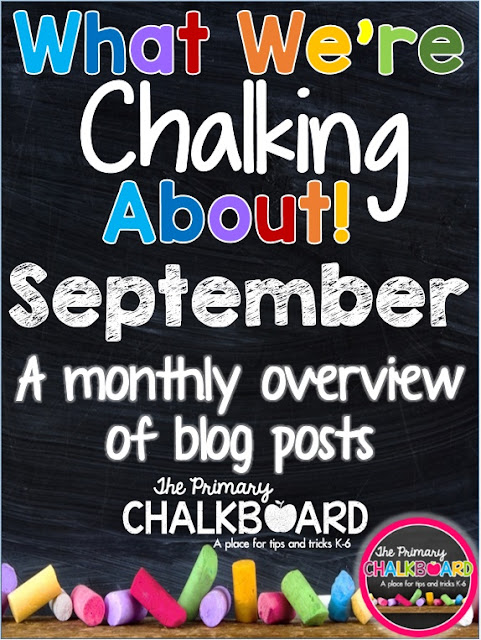Hi all, Happy September! What the what? September, oh my... How did that happen?
It's Emma from Clever Classroom bringing you another, ''What We're Chalking About" post that covers what our multi-talented, cyber writers are posting about this month, via a visual calendar.
As you can see, our visual calendar aims to help you preview who and what is being posted.
We have content for both primary and intermediate students, and topics that cover science, social studies, literacy, math, routines, planning and themes.
This month, we are also featuring a few flash back posts, which we have aptly named, "Way Back Wednesday".
If you would like to receive notifications from us this month, click here to follow our blog.
Here's what we have planned for you this month.
1 Jessica from Second Grade Nest - Labor Day
2 Way Back Wednesday
3 Haley from My Silly Firsties - Morning Messages
4 Vicky from Teaching and Munch Moore - Poems in Primary Classrooms
5 Matt from Digital Divide and Conquer - MVP Partner Management
6 Autumn from The Primary Techie - Remembering 9/11
7 Karen from Mrs. Jone's Class - Interactive Notebooks
8 Nicole from Mrs. Rios Teaches - Back to School Night
9 Way Back Wednesday
10 Valerie from All Students can Shine - Primary Ideas
11 Naomi from Read Like a Rockstar - Class Newsletters
12 Sarah from Sarah's First Grade Snippets - Parent Involvement
13 Anna from Simply Skilled in 2nd - Constitution Day
14 Emma from Clever Classroom - Social Skills and Classroom Expectations
15 Terry from Terry's Teaching Tidbits - Senses
16 Way Back Wednesday
17 Katie from Teacher to the Core - Bats on the Brain
18 Laura from Peace Love and First Grade - Easy Ideas for Fundraising
19 Jennifer from Teaching to Inspire - 3-5 Ideas
20 Meg from The Teacher Studio - Accountable Talk
21 Ariane from The Science Penguin - The 5E Model Engage
22 Alyssha from Teaching and Tapas - Primary Ideas
23 Way Back Wednesday
24 Latoya from Flying into First Grade - Math Talks
25 Lisa from Growing Firsties - Student Goal Setting
26 Corinna from Surfin' Through Second - Math Games
27 Cyndie from Chalk One up for the Teacher - What's for Lunch?
28 Heather from 2 Brainy Apples - Social Studies
29 John from An Educators Life - Positive Culture
30 October's What We're Chalking About: October - Visual Calendar
To remember this post, you might like to pin it. That way, you can come back to see the posts throughout the month.
On the last day of each month, we will post this visual calendar for you to see what we have planned.
If you have any suggestions that you would like us to write about, please comment below.
Click here to see our posts from July.
Click here to see our posts from August.
Thanks so much for dropping by.




















































